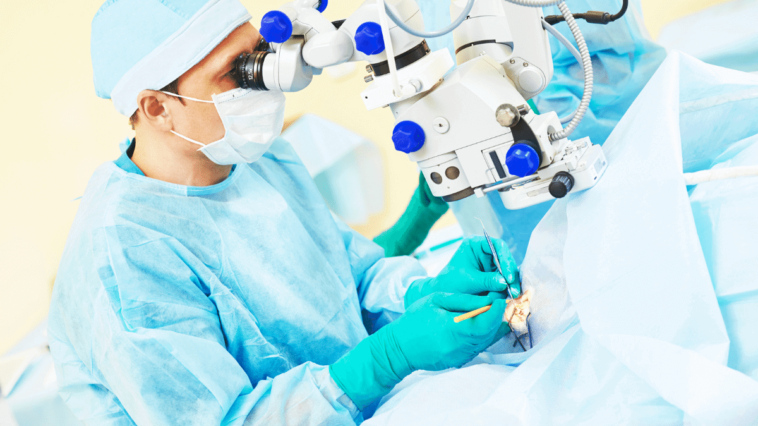LASIK Surgery is an advanced surgical procedure that provides a long-lasting remedy to Cornea related and other types of eye ailments in patients. It helps patients to get out of the clutches of Contact Lens and Eye Glasses.
Let us have a detailed look at the exact way LASIK works for a better understanding of the same. Before diving into understanding how a LASIK works, it is important that the meaning and terminologies about LASIK are understood.
LASIK definition
The expansion of LASIK is Laser in Situ Keratomileusis. The simple meaning of this term is
Laser: Using Laser rays
In situ: At the lower side of the Cornea
Keratomileusis: For reshaping the Cornea
A special type of Laser is used during the reshaping procedure of the Cornea with the help of Lasik surgery. This laser is termed as Excimer and helps correct vision-related problems in people in a precise manner. Excimer laser procedure also helps to improve the vision in people who requires vision correction solutions.
Refractive Errors also get corrected through Lasik surgeries performed using Excimer Laser. To summarize the working of Lasik, Excimer laser is used underneath the Cornea for reshaping the same.
Requirements for the perfect working of LASIK Surgery
Every treatment has specific requirements for the same to be successful and so does the Lasik procedure too. LASIK Surgery works perfectly fine when the following requirements are met to the required levels.
An expert surgeon who is specially trained in Lasik procedure
The patient must be at least 18 years plus
Eyes of the patients are healthy without the following eye-related ailments
Any abnormalities in Cornea like infections or scars
Presence of Astigmatism
Nearsightedness ranging from moderate to severe levels
Farsightedness ranging from mild to moderate levels
Ability to lie flat on the plain surface so it does not pose a problem during surgery
Ability to focus on light source continuously for a minute or more since starting at specific spots during the surgery is mandatory
The suitability of candidacy for a Lasik surgery depends mostly on the shape of the Cornea. Willingness and capability to manage without Contact Lens for at least four weeks before surgery is one of the primary requirements for a Lasik surgery to be performed on a person
Willingness to sign the consent form before undergoing the Lasik surgery
Refractive errors corrected when LASIK Surgery works out
When Lasik works out perfectly, solutions to different types of eye-related ailments are provided in the following ways.
Astigmatism – Retina gets filled up with many images due to the distortion in the shape of the lens or Cornea. Things beyond a distance causes appear blurred due to this. This is one type of refractive error which gets corrected by Lasik
Hyperopia – Termed as farsightedness in normal life, this type of refractive error makes the objects nearby look blurred and the objects in distance places look clear
Myopia – Termed as nearsightedness in normal life, the length of the eyes and the mismatch found in the focussing power makes objects at a distance look blurry and object nearby to look clear
Terminologies used in working out LASIK
Understanding certain terminologies about LASIK surgery will help people easily decipher the meanings of the same while studying about how Lasik works. Some such crucial terminologies associated with LASIK surgery are given below
Numbing drops – Anesthetic drops applied by the Ophthalmologist pulling the lower eyelid down. These drops take effect within 10 to 15 minutes.
Flap – Flap is a protective shield created with the help of a blade or Laser
The laser ablates: Laser reshaping
Bilateral Lasik: LASIK surgery performed on both the eyes of a patient
Bladeless Lasik: Corneal flap is created individually for every patient in a bladeless manner
Epithelium: Epithelium is a soft tissue found in front of the Cornea covering the same
Excimer Laser: This is the special laser used in Lasik Surgery for Corneal corrections. This laser uses ultraviolet rays for performing the action
Hyperopia: Farsightedness
HOA: Higher-order aberrations – Decreased vision during nights, halos, and glares
Intraocular: Inside the eyes
Keratectomy: Process of removing tissues to correct the shape of the Cornea
LASIK Candidate: The patient who qualifies for the Lasik surgery satisfying the criteria set for the same
LASIK consultation: Complete check-up to determine the health of the eye and the candidate’s suitability for a Lasik surgery
LASEK: Is a similar procedure to Lasik but differs in the manner in which the flap is created before the surgery
Lens: A crucial part of the eyes behind Iris.
Lid Speculum: Surgical device used to hold the eyelid apart in a professional manner
Lower order aberrations: Refractive errors like Hyperopia, Myopia, and Astigmatism
Microkeratome: A surgical instrument used to create a corneal flap before the Lasik surgery
Monofocal Lens: A lens placed inside allowing vision from a specific distance
Multifocal Lens: Lens that offers a clear vision for more than one distance
Myopia: Nearsightedness
Night Glare: Halos in vision particularly during the night times
Off label use: Recommendations of medicines by Medical Professionals for uses not intended by the manufacturers
Overcorrection: A possible side effect post Lasik where the eye responds in an excessive manner leading to excess correction of issues
Presbyopia: Eye ailments people above 40 or 50 years experience
Photorefractive Keratectomy: PRK – Vision correction procedure
Toric Lens: Lens used to correct issues related to Astigmatism
Wavefront Analyzer: A technology which helps in the creation of eye visual system in a three-dimensional manner
How exactly does LASIK Surgery works
LASIK Surgery begins with the patient and ends with an Ophthalmologist. LASIK Surgery can be divided into five parts.
1. Application of Anesthesia
This acts as the beginning of Lasik surgery. Right from this stage, only an Ophthalmologist is eligible to get involved in the procedure. The Ophthalmologist holds the lower eyelid apart from the eyes with the help of a surgical device named Lid Speculum. This device helps the Ophthalmologist to hold the eyelids of the patients professionally. Holding the eyelids for the application of anesthesia makes the patient feel the same but without causing any pain. Anesthesia applied in the eyes is also termed as numbing drops. The Ophthalmologist applies the numbing drops and observes the patients for a few minutes.
Usually, numbing drops take a minimum of 10 minutes to a maximum of 15 minutes to make the eyes numb. If the Ophthalmologist feels that more numbing drops need to be administered on the eyes after the first dosage, he will do the same as the second dosage. While the complete process of administering numbing drops makes the patient realize the happenings in the process, no pain is caused during any stage.
2. Flap creation
Flap creation is the next step in Lasik surgeries. Flap creation is done in many ways depending on the type of surgery. For instance, Lasik and Lasek surgeries differ only in the flap creation process and all other steps involved are almost the same. We will look at some ways in which flaps are created during a LASIK Surgery.
Traditional Lasik Flap creation
In this format, a surgical instrument named Microkeratome is used to make an incision on the surface of the Cornea. A microkeratome is a surgical instrument that is small in size and has a disposable blade attached to it. This blade is used for creating the incision on the Cornea in a controlled manner. This cut part acts as the flap which is lifted by the Ophthalmologist to make the Excimer laser pass through the eyes to reshape the Cornea and correct the vision problems. This method is known as bladed flap creation.
Femtosecond Bladeless Lasik Flap creation
In this method, flap creation is done without the use of any type of blade. ‘Femtosecond Laser’ which is a high energy form of Laser is used to create a flap. This flap is then appropriately handled by the Ophthalmologist to make the Excimer Laser rays pass through the eyes. Excimer Rays correct vision problems and reshape Cornea to rid the patient out of vision-related issues. This method of flap creation is also termed popularly as ‘All Laser’ or ‘Bladeless’.
Intralase Bladeless Lasik Flap creation
This form of flap creation is one of the first methods approved by the FDA as early as in the year 2007. This is now termed as iLasik in the Lasik markets.
Key points to note about flaps during LASIK surgery
Irrespective of the way flaps are created during Lasik surgeries, the vision gets blurred or becomes dim. This is a normal phenomenon that occurs in patients with all types of ailments.
Flaps are flaps whether they are created in a bladeless manner or using a blade. They need to be created so the Ophthalmologist can pass the lasers into the eyes for vision correction and Cornea reshaping purposes
With all said and done, Blades and Lasers are instruments and are only as effective and safe as handled by the Ophthalmologist.
3. Reshaping of the Cornea
The third step to understand to have clarity about how Lasik works is the main aspect for which the surgery is performed. Lasik is usually performed for two purposes namely reshaping the Cornea and vision correction for people suffering from Hyperopia, Myopia, and Astigmatism. The process of reshaping the Cornea addresses the vision-related problems mentioned above in an automatic manner. The process of Cornea reshaping is given below in a step by step manner.
The layer named Stroma is the one that gets reshaped through Excimer Laser
This layer is found in the Cornea of the eyes
The laser passes on through this layer of the Cornea removing cells as per the individualized prescription which is usually unique.
During the reshaping process, the patient undergoing the surgery sees green light or red light
The computer connected to the devices constantly tracks the movement of the eye every nanosecond to check the precision of the procedure
The patient may smell a queer odor and hear mild clicking sounds during the procedure which is absolutely a normal happening
LASIK surgery, while reshaping the Cornea tends to take care of other vision-related problems like Astigmatism, Hyperopia, and Myopia in an automatic manner.
4. Replacing the flap
Flap replacement is the last step in the Lasik surgery process and needs to be done with utmost care to complete the surgery successfully.
Lasik surgery generally takes 25 to 30 minutes.
The lifted flap gets replaced by the surgeon with the help of special instruments available for the purpose
Healing of the incision starts happening as soon as the surgery is over
The surgeon may apply eye drops to initiate the healing process and quick healing purposes
5. Post LASIK Surgery experience
Post LASIK Surgery is a crucial phase during which the instructions given for quick recovery must be diligently followed by the patients.
Patients may feel irritation in the eyes on which Lasik has been done for a few hours post-surgery
Water may ooze of the operated eyes for the first few couples of hours or lesser duration than that
Clear vision is regained by the patients on the night of the surgery or the next day.
During the first week after the surgery steroidal and antibacterial eye, drops must be applied in the eyes in the prescribed periodicities.
Post-surgery visits for follow-up checkups must be done for the first one-year period at increasing duration levels like one day, one week, one month, and so on.
The majority of the patients who undergo Lasik surgery get back their normal vision levels within one-year duration.






